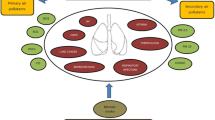Abstract
Patients with pulmonary disease are often unable to complete forced expiration manœuvres. The aim of the study is to evaluate whether forced vital capacity (FVC), the volume exhaled at the end of completed forced expiration, can be estimated by extrapolating volume-time curves obtained from uncompleted manœuvres. The suitability of mono-, bi-, and tri-exponential functions to characterise complete volume-time curves from 50 subjects is investigated. Mono-exponential modelling is insufficient, whereas bi-exponential fitting yields an adequate description for 47 data sets. Tri-exponential models lead to overfitting in all but three cases (normalised sum of least squares: 50.2±34.5 for mono-2.76±4.11 for bi-, 2.74±4.19 for tri-exponential modelling; condition number of the correlation matrix: 1.0025±0.0004 for mono-, 1.08±0.08 for bi-, 34.7±100.1 for tri-exponential fitting (mean±SD)). Thus, FVC is estimated by the extrapolation of 27 uncompleted spirograms using bi- or tri-exponential models, depending on their accordance with measured data and on the identifiability of their parameters. This algorithm yields unbiased estimates (difference from measured inspiratory vital capacity: 0.01±0.21 L). This method can be used for investigation of the lung function of subjects who cannot complete the forced expiration manœuvre.
Similar content being viewed by others
References
American Thoracic Society (1995): ‘Standardization of spirometry’,Am. J. Respir. Crit. Care Med.,152, pp. 1107–1136
Chelucci, G. L., Brunet, F., Dall'Ava-Santucci, J., Dhainaut, J. F., Paccaly, D., Armaganidis, A., Milic-Emili, J., andLockhart, A. (1991): ‘A single-compartment model cannot describe passive expiration in intubated, paralysed humans’,Eur. Respir. J.,4, pp. 458–464
Chelucci, G. L., Dall'Ava-Santucci, J., Dhainaut, J. F., Chelucci, A., Allegra, A., Paccaly, D., Brunet, F., Milic-Emili, J., andLockhart, A. (1993): ‘Mocelling of passive expiration in patients with adult respiratory distress syndrome’,Eur. Respir. J.,6, pp. 785–790.
Chhabra, S. K. (1998): ‘Forced vital capacity, slow vital capacity, or inspiratory vital capacity: which is the best measure of vital capacity?’,J. Asthma.,35, pp. 361–365
Guttmann, J., Eberhard, L., Fabry, B., Bertschmann, W., Zeravik, J., Adolph, M., Eckart, J., andWolff, G. (1995): ‘Time constant/volume relationship of passive expiration in mechanically ventilated ARDS patients’,Eur. Respir. J.,8, pp. 114–120
Hedman, J., Kaprio, J., Poussa, T., andNieminen, M. M. (1999): ‘Prevalence of asthma, aspirin intolerance, nasal polyposis and chronic obstructive pulmonary disease in a population-based study’,Int. J. Epidemiol.,28, pp. 717–722.
Permutt, S., andMenkes, H. A. (1979): ‘Spirometry: analysis of the forced expiration within the time domain’ inMacklem, P., andPermutt, S. (Eds): ‘The lung in transition from health to disease’, Vol. 12, Lung biology in health and disease (Marcel Dekker, New York), pp. 113–152.
Pimmel, R. L., Miller III, T. K., Fouke, J. M., and Eyles, J. G. (1981): ‘Time-constant histograms from the forced expired volume signal’,J. Appl. Physiol.,51, pp. 1581–1593
Press, W. H., Teukolsky, S. A., Vetterling, W. T., andFlannery, B. P. (1992); ‘Numerical recipes in C’ (Cambridge University Press, Cambridge)
Revelly, J. P., Feihl, F., Liebling, T., andPerret, C. (1989): ‘Time constant histograms from the forced expired volume signal: a clinical evaluation’,Eur. Respir. J.,2, pp. 536–542
Rotger, M., Navajas, D., andFarré, R. (1989): ‘A least squares algorithm to determine the mechanical time constant distribution of the lung during forced expiration’,Int. J. Biomed. Comput.,24, pp. 29–40
Author information
Authors and Affiliations
Corresponding author
Rights and permissions
About this article
Cite this article
Steltner, H., Vogel, M., Sorichter, S. et al. Analysis of forced expired volume signals using multi-exponential functions. Med. Biol. Eng. Comput. 39, 190–194 (2001). https://doi.org/10.1007/BF02344803
Received:
Accepted:
Issue Date:
DOI: https://doi.org/10.1007/BF02344803




